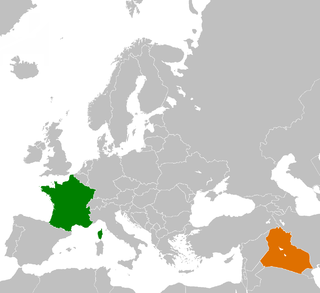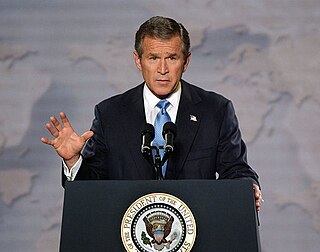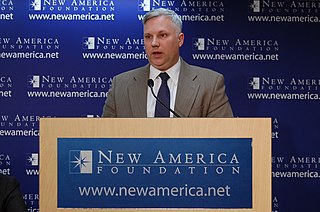Related Research Articles

Saddam Hussein Abd al-Majid al-Tikriti, was an Iraqi politician and revolutionary who served as the fifth president of Iraq from 1979 to 2003. He also served as prime minister of Iraq from 1979 to 1991 and later from 1994 to 2003. He was a leading member of the revolutionary Arab Socialist Ba'ath Party, and later, the Baghdad-based Ba'ath Party and its regional organization, the Iraqi Ba'ath Party, which espoused Ba'athism, a mix of Arab nationalism and Arab socialism.

This article describes the positions of world governments before the actual initiation of the 2003 invasion of Iraq, and not their current positions as they may have changed since then.

George Frost Kennan was an American diplomat and historian. He was best known as an advocate of a policy of containment of Soviet expansion during the Cold War. He lectured widely and wrote scholarly histories of the relations between the USSR and the United States. He was also one of the group of foreign policy elders known as "The Wise Men".

Containment was a geopolitical strategic foreign policy pursued by the United States during the Cold War to prevent the spread of communism after the end of World War II. The name was loosely related to the term cordon sanitaire, which was containment of the Soviet Union in the interwar period.

In political science, rollback is the strategy of forcing a change in the major policies of a state, usually by replacing its ruling regime. It contrasts with containment, which means preventing the expansion of that state; and with détente, which means developing a working relationship with that state. Most of the discussions of rollback in the scholarly literature deal with United States foreign policy toward communist countries during the Cold War. The rollback strategy was tried and was not successful in Korea in 1950 and in Cuba in 1961, but it was successful in Grenada in 1983. The United States discussed the use of rollback during the East German uprising of 1953 and the Hungarian Revolution of 1956, which were ultimately crushed by the Soviet Army, but decided against it to avoid the risk of a major war.

Kenneth Michael Pollack is an American former CIA intelligence analyst and expert on Middle East politics and military affairs. He has served on the National Security Council staff and has written several articles and books on international relations. Currently, he is a resident scholar at the American Enterprise Institute, "where he works on Middle Eastern political-military affairs, focusing in particular on Iran, Iraq, Saudi Arabia, and the Gulf countries. Before that he was Senior Fellow at the Saban Center for Middle East Policy at the Brookings Institution and a senior advisor at Albright Stonebridge Group, a global business strategy firm.
On 6 August 1990, four days after the Iraqi invasion of Kuwait, the United Nations Security Council (UNSC) placed a comprehensive embargo on Iraq. The sanctions stayed largely in force until 22 May 2003, and persisted in part, including reparations to Kuwait. The original stated purposes of the sanctions were to compel Iraq to withdraw from Kuwait, to pay reparations, and to disclose and eliminate any weapons of mass destruction (WMD).

There are various rationales for the Iraq War, both the 2003 invasion of Iraq and the subsequent hostilities. The George W. Bush administration began actively pressing for military intervention in Iraq in late 2001. The primary rationalization for the Iraq War was articulated by a joint resolution of the United States Congress known as the Iraq Resolution. The US claimed the intent was to "disarm Iraq of weapons of mass destruction, to end Saddam Hussein's alleged support for terrorism, and to supposedly free Iraqi people".
David Wurmser is an American foreign policy specialist. He served as Middle East Adviser to former US Vice President Dick Cheney, as special assistant to John R. Bolton at the State Department and as a research fellow on the Middle East at the American Enterprise Institute (AEI). He served in the U.S. Navy Reserve as an intelligence officer at the rank of Lieutenant Commander.
American support for Ba'athist Iraq during the Iran–Iraq War, in which it fought against post-revolutionary Iran, included several billion dollars' worth of economic aid, the sale of dual-use technology, military intelligence, and special operations training. The U.S. refused to sell arms to Iraq directly due to Iraq's ties to terrorist groups, but several sales of "dual-use" technology have been documented; notably, Iraq purchased 45 Bell helicopters for $200 million in 1985. Of particular interest for contemporary Iran–United States relations are accusations that the U.S. government actively encouraged Iraqi leader Saddam Hussein to invade Iran, supported by a considerable amount of circumstantial evidence and generally regarded as the conventional wisdom in the Arab world, but several scholars and former U.S. government officials deny that any such collusion occurred, and no direct documentary proof of it has been found.
The foreign policy of the Bill Clinton administration was of secondary concern to a president fixed on domestic policy. He relied chiefly on his two experienced Secretaries of State Warren Christopher (1993–1997) and Madeleine Albright (1997–2001), as well as Vice President Al Gore. The Cold War had ended and the Dissolution of the Soviet Union had taken place under his predecessor President George H. W. Bush, whom Clinton criticized for being too preoccupied with foreign affairs. The United States was the only remaining superpower, with a military strength far overshadowing the rest of the world. There were tensions with countries such as Iran and North Korea, but no visible threats. Clinton's main priority was always domestic affairs, especially economics. Foreign-policy was chiefly of interest to him in terms of promoting American trade. His administration signed more than 300 bilateral trade agreements. His emergencies had to do with humanitarian crises which raised the issue of American or NATO or United Nations interventions to protect civilians, or armed humanitarian intervention, as the result of civil war, state collapse, or oppressive governments.

United States foreign policy in the Middle East has its roots in the early 19th-century Tripolitan War that occurred shortly after the 1776 establishment of the United States as an independent sovereign state, but became much more expansive in the aftermath of World War II. With the goal of preventing the Soviet Union from gaining influence in the region during the Cold War, American foreign policy saw the deliverance of extensive support in various forms to anti-communist and anti-Soviet regimes; among the top priorities for the U.S. with regards to this goal was its support for the State of Israel against its Soviet-backed neighbouring Arab countries during the peak of the Arab–Israeli conflict. The U.S. also came to replace the United Kingdom as the main security patron for Saudi Arabia as well as the other Arab states of the Persian Gulf in the 1960s and 1970s in order to ensure, among other goals, a stable flow of oil from the Persian Gulf. As of 2023, the U.S. has diplomatic relations with every country in the Middle East except for Iran, with whom relations were severed after the 1979 Islamic Revolution, and Syria, with whom relations were suspended in 2012 following the outbreak of the Syrian Civil War.

Iraq–Saudi relations are the bilateral and diplomatic relations between the Republic of Iraq and the Kingdom of Saudi Arabia. Both sovereign states share the Iraq–Saudi Arabia border.

French–Iraq relations are the relations between France and Iraq. France played a major role in Iraqi secession from the Ottoman Empire and eventual freedom from British colonial status. The Franco-Iraqi relationship is often defined by conflict and peace, with France supporting Iraq during the Iran-Iraq War, supporting intervention in Iraq in Operation Desert Storm, and opposing the 2003 U.S. Invasion of Iraq. As of 2004, Iraq maintains an embassy in Paris and France maintains an embassy in Baghdad and a consulate general in Erbil.

Prior to the Iraq War, the United States accused Iraq of developing weapons of mass destruction and having links with al-Qaeda. In 1991, the United Nations Security Council Resolution 687 was adopted and subsequent UN weapons inspectors were inside Iraq. This period also saw low-level hostilities between Iraq and the United States-led coalition from 1991–2003.

After World War I, Iraq passed from the failing Ottoman Empire to British control. Kingdom of Iraq was established under the British Mandate in 1932. In the 14 July Revolution of 1958, the king was deposed and the Republic of Iraq was declared. In 1963, the Ba'ath Party staged a coup d'état and was in turn toppled by another coup in the same year, but managed to retake power in 1968. Saddam Hussein took power in 1979 and ruled Iraq for the remainder of the century, during the Iran–Iraq War of the 1980s, the Invasion of Kuwait and the Gulf War of 1990 to 1991 and the UN sanction during the 1990s. Saddam was removed from power in the 2003 invasion of Iraq.

Ba'athist Iraq, officially the Iraqi Republic (1968–1992) and later the Republic of Iraq (1992–2003), was the Iraqi state between 1968 and 2003 under the rule of the Arab Socialist Ba'ath Party. This period began with high economic growth, but ended with the country facing severe levels of socio-political isolation and economic stagnation. By the late 1990s, the average annual income had decreased drastically due to a combination of external and internal factors. UNSC sanctions against Iraq, in particular, were widely criticized for negatively impacting the country's quality of life, prompting the establishment of the Oil-for-Food Programme. The Ba'athist period formally came to an end with the 2003 invasion of Iraq, and the Ba'ath Party has since been indefinitely banned across the country.

Joel Rayburn is a retired United States Army officer, former diplomat, and historian who served as the United States Special Envoy for Syria from 2018 to 2021. He has published books and articles about the American invasion of Iraq in 2003 and its results. From January to July 2021 he served as a special advisor for Middle East affairs to U.S. Senator Bill Hagerty (R-TN). He is currently a Fellow in the National Security Program at the New America Foundation.

Iran and Saudi Arabia are engaged in an ongoing struggle for influence in the Middle East and other regions of the Muslim world. The two countries have provided varying degrees of support to opposing sides in nearby conflicts, including the civil wars in Syria and Yemen; and disputes in Bahrain, Lebanon, Qatar, and Iraq. The struggle also extends to disputes or broader competition in other countries globally including in West, North and East Africa, South, Central, Southeast Asia, the Balkans, and the Caucasus.
The Gulf War began on the 2 August 1990, when Iraq invaded Kuwait. The war was fought between the international coalition led by the United States of America against Iraq. Saddam Hussein's rationale behind the invasion is disputed and largely unknown. No Iraqi document has ever been discovered explicitly listing these.
References
- 1 2 Landpower and dual containment - rethinking America's policy in the gulf. Archived 2009-06-05 at the Wayback Machine - by Stephen C. Pelletiere, Strategic Studies Institute, US Army War College, November 1999
- ↑ America's Misguided Policy of Dual Containment in the Persian Gulf - Cato Foreign Policy Briefing No. 33, by Barbara Convay, Cato Institute, November 10, 1994
- ↑ Indyk, pp. 32–33.
- ↑ Indyk, Martin (2009-01-06). Innocent Abroad: An Intimate Account of American Peace Diplomacy in the Middle East . Simon & Schuster. pp. 30, 32. ISBN 9781416597254 . Retrieved 22 December 2013.
- ↑ Indyk, p. 32.
- ↑ Indyk, pp. 33–36.
- ↑ Indyk, pp. 36–37.
- ↑ Indyk, p. 38.
- ↑ David Von Drehle & R. Jeffrey Smith (27 June 1993). "U.S. Strikes Iraq for Plot to Kill Bush". The Washington Post . Retrieved 22 December 2013.
- ↑ "Transcript: President Clinton explains Iraq strike". CNN. 16 December 1998. Retrieved 22 December 2013.
- ↑ Indyk, p. 39.
- ↑ Indyk pp. 39–41.
- ↑ BAHGAT, GAWDAT (1997). "Beyond Containment: US–Iranian Relations at a Crossroads". Security Dialogue. 28 (4): 454 – via JSTOR.
- ↑ Indyk, pp. 56–57.
- ↑ Mirhosseini, p. 37.
- ↑ Thalif Deen (September 27, 2000). "UN's 10-year-old Embargo on Iraq Threatens to Unravel". Common Dreams NewsCenter. Archived from the original on 28 June 2012. Retrieved 21 February 2014.
- ↑ Daniel Pipes (2 March 1995). "Two Cheers for Dual Containment" . Retrieved 22 December 2013.
- ↑ F. Gregory Gause III (March–April 1994). "The Illogic of Dual Containment". Foreign Affairs. 73 (2): 56–66. doi:10.2307/20045919.
- ↑ Barbara Conry (10 November 1994). "America's Misguided Policy of Dual Containment in the Persian Gulf". Cato Foreign Policy Briefing. Cato Institute. 33.
- 1 2 3 The Israel Lobby and U.S. Foreign Policy - by John Mearsheimer and Stephen Walt, London Review of Books, 23 March 2006
- ↑ Crossette, Barbara (1 December 1995). "Iraq Sanctions Kill Children, U.N. Reports". The New York Times. p. 9. Retrieved 21 February 2014.
- ↑ Dyson, Tim; Cetorelli, Valeria (2017-07-24). "Changing views on child mortality and economic sanctions in Iraq: a history of lies, damned lies and statistics". BMJ Global Health . 2 (2): e000311. doi:10.1136/bmjgh-2017-000311. ISSN 2059-7908. PMC 5717930 . PMID 29225933.
- ↑ Sly, Liz (2017-08-04). "Saddam Hussein said sanctions killed 500,000 children. That was 'a spectacular lie.'". The Washington Post . Retrieved 2020-04-22.